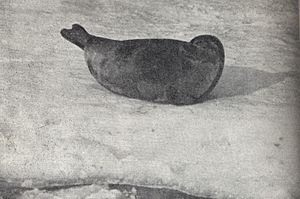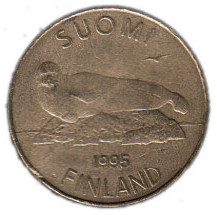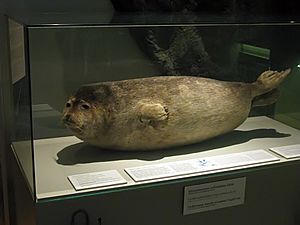Saimaa ringed seal facts for kids
Quick facts for kids Saimaa ringed seal |
|
|---|---|
 |
|
| Conservation status | |
| Scientific classification | |
| Kingdom: | |
| Phylum: | |
| Class: | |
| Order: | |
| Family: | |
| Genus: |
Pusa
|
| Species: | |
| Subspecies: |
P. h. saimensis
|
| Trinomial name | |
| Pusa hispida saimensis (Nordquist, 1899)
|
|
 |
|
| Synonyms | |
|
|
|
The Saimaa ringed seal (Pusa hispida saimensis) is a subspecies of ringed seal (Pusa hispida). Usually seals live in the sea, but Saimaa ringed seals live in Lake Saimaa in Finland. There are only 320 Saimaa ringed seals in the world. They are among the most endangered seals in the world.
After the last ice age was over, dry land was rising slowly. This isolated Lake Saimaa from the sea. Some seals were also isolated in Saimaa. Their successors become Saimaa ringed seals.
Contents
Distribution
Habitat
The habitat of the Saimaa ringed seal is Lake Saimaa, Finland. The lake spans a circumference of approximately 180 Km X 140 Km and It has an area of 443 sq mi (1,147 sq km) and is relatively shallow, averaging about 12m deep and has a max depth of 85 m. Lake Saimaa contains approximately 13,000 islands and has over 14,850 km of shoreline. The freshwater lake freezes over between the months of November and May. Leaving the seals to two types of habitats throughout the year; the ice habitat and open water habitat. The freezing accompanied with the lakes natural architecture create a labyrinth-like habitat for the seals. During summer months when the ice is melted these islands provide ample space for the seals to molt and breed.
Range
Saimaa ringed seals are named as such due to their only habitat being Lake Saimaa, Finland. Thus, their range is restricted only to the waters of Lake Saimaa and its and surrounding banks.
Appearance
An adult Saimaa ringed seal is between 85 and 160 centimetres (2.79 and 5.25 ft) in length and weighs between 50 and 90 kilograms (110 and 200 lb); males usually being larger than females. They are coloured dark gray, with a gray-black dorsal with circular white rings. The bottom is light gray. The Saimaa ringed seal is darker in color than other ringed seals.
Diet
The Saimaa ringed seal does not have an incredibly varied diet. They are generalist feeders and eat exclusively fish. The fish consumed consist primarily small schooling fish averaging 8.6 cm in length and up to 21 cm in length, while it has been shown that the pups eat slightly smaller fish than the average. The majority of their diet consists of vendace, smelt, perch and roach. The pups’ diet varies markedly from the adults in that their diet consists primarily of perch and roach found in the shallow water where they spend most of their time in their earlier months while the adults consume more vendace and smelt.
It was believed for a long time that the Saimaa ringed seal was competing with the commercial and recreational fishing industries and there were bounties paid on them until the 1940’s. However it has recently been proven that the Saimaa ringed seal has minimal to no effect on the fishing industry. They do not prey on the local endangered salmon species(Salmo salar m. Sebago, S. trutta m. lacustris, and Salvelinus alpines) and although they do prey on the valuable vendace population, the proportion of the vendace population to the amount consumed by the seals indicates that they do not compete with the local fishing industries.
Behavior
Reproduction
Ringed seals' gestation lasts 11 months. Their pups are between 55 and 65 centimetres (1.80 and 2.13 ft), and 4 to 5 kilograms (8.8 to 11.0 lb) at birth. The Saimaa ringed seal's longevity is just over 20 years.
Diving

Diving is an important behavior for marine mammals as it is something they rely on for behaviors such as foraging and travelling. The duration of their dives increases from spring to autumn, which may be a result of food availability, but is interesting because they are one of the few land locked seal species. Many studies have been done to observe Saimaa ringed seal diving, and has been discovered to last longer than expected. Their average time for a long dive was recorded to last for 15 min and was believed to be an aerobic resting dive.
The average dive depth ranges from 10 to 15 m, however, their maximum dive depths were limited by environmental depth. The saimaa ringed seal has also been observed to have seasonal hauling-out patterns. In May and June, when the seals are molting, they are observed to haul out both day and night, however, in late summer they are observed to haul out only at night.
The saimaa ringed seal is able to complete its dives and navigate in its environment due to its highly developed vibrissae, also known as whiskers. Using their vibrissae they are able to detect sound and pressure waves in their otherwise dark environment.
Images for kids
See also
 In Spanish: Foca anillada de Saimaa para niños
In Spanish: Foca anillada de Saimaa para niños




